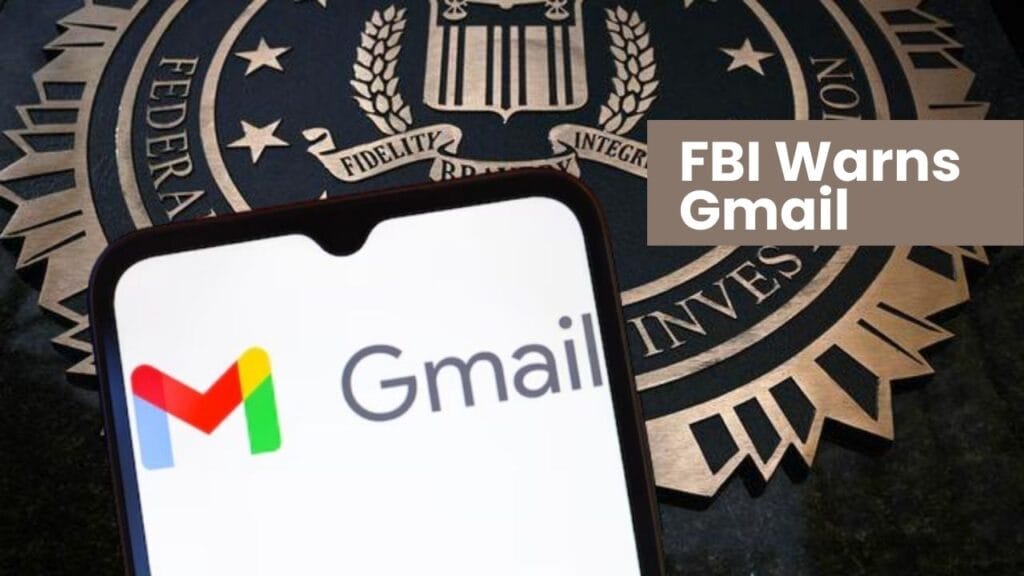The FBI and US Cybersecurity and Infrastructure Security Agency (CISA) have issued a stark warning to 1.8 billion Gmail users worldwide about an alarming wave of ransomware attacks.
With hackers deploying Medusa ransomware and new AI-powered phishing scams, users are being urged to act swiftly to protect their accounts before it’s too late.
Rising Gmail Attacks: What’s Happening?
1. Medusa Ransomware — A Global Threat
The FBI has flagged Medusa, a highly dangerous ransomware that has targeted over 300 organizations, including hospitals, schools, and major businesses. The attack starts with phishing emails and fake login pages, tricking users into revealing their credentials. Once inside, hackers:
- Lock all crucial files and create copies.
- Demand ransom between $100,000 and $15 million to release the data.
- Threaten to leak sensitive information if payments aren’t made.
2. Gmail Account Lockout Hack — You Have 7 Days to Act
Google has reported an increase in account hijacking cases, where cybercriminals take full control of a Gmail account by:
- Changing the password, phone number, and recovery email.
- Locking users out permanently.
Google allows a 7-day grace period to reclaim your account if your recovery phone number or email is changed. If you act within this time, you may be able to regain access before the hacker fully takes over.
3. AI-Powered Phishing Scams on the Rise
Cybersecurity researchers from Trend Micro have discovered that hackers are now using AI-generated lies to create convincing phishing emails and messages. These scams:
- Use fake ChatGPT, VR, or tech updates as bait.
- Start with simple scam emails to gauge if you are a likely target.
- If you respond, a real human hacker takes over to execute the full attack.
How to Protect Your Gmail and Online Accounts
✅ Enable Two-Factor Authentication (2FA) — Always use an authenticator app instead of SMS.
✅ Act Fast If You’re Locked Out — Use Google’s 7-day recovery window.
✅ Update Your Software & Devices — Patch known vulnerabilities immediately.
✅ Be Wary of Phishing Emails — Don’t click suspicious links or enter credentials on fake sites.
✅ Use Strong, Unique Passwords — Never reuse passwords across accounts.
✅ Segment Networks (For Businesses) — Prevent infected devices from spreading malware.
1. What is 2FA and Why Use an Authenticator App?
Two-factor authentication (2FA) adds an extra layer of security to your account. Instead of just using a password, it requires a second step (like a code from an app) to verify it’s really you.
Why use an authenticator app instead of SMS?
✅ More Secure — Hackers can steal SMS codes using SIM-swap attacks, but authenticator apps are harder to hack.
✅ Works Without a Phone Signal — Unlike SMS, the app generates codes offline.
How to Enable 2FA Using an Authenticator App
Step 1: Install an Authenticator App
You’ll need an authenticator app like:
📌 Google Authenticator (Android/iPhone) → [Download from Play Store or App Store]
📌 Microsoft Authenticator (Android/iPhone)
📌 Authy (Android/iPhone) → Offers cloud backup
Step 2: Enable 2FA on Your Google Account
1️⃣ Go to your Google Account Security page:
- Open Google Security Settings.
- Scroll down to “2-Step Verification” and click it.
2️⃣ Click “Get Started” and sign in if needed.
3️⃣ Choose “Authenticator App” (NOT SMS!)
- Click “Set up another method”
- Select “Authenticator app”
4️⃣ Scan the QR Code
- Open the Authenticator App on your phone.
- Tap “+” or “Add Account”.
- Choose “Scan a QR Code” and point your camera at the QR code on the screen.
5️⃣ Enter the 6-digit code from the app into Google and click Verify.
✅ Done! Now every time you log in, you’ll open the Authenticator App to get a new code (which changes every 30 seconds).
What If I Lose My Phone?
📌 Backup Codes — Google gives you 10 backup codes. Write them down or store them safely.
📌 Use Authy — If you use Authy, it can back up your 2FA codes to the cloud (Google Authenticator doesn’t do this).
2. How to use Google’s 7-Day Recovery Window
If a hacker takes over your account, they might:
❌ Change your password so you can’t log in.
❌ Remove your recovery email/phone so you can’t reset it.
❌ Enable 2FA for themselves so you get locked out.
Good News: You Have a 7-Day Recovery Window!
Google allows the original account owner (you) to undo changes within 7 days of a hacker changing your recovery details.
🚨 This means you must act FAST!
How to Recover Your Gmail Account Within 7 Days
Step 1: Go to Google Account Recovery
1️⃣ Open Google’s Account Recovery page.
2️⃣ Enter your Gmail address.
3️⃣ Click “Forgot password?”
Step 2: Try Your Last Password
- Google may ask for your last password. If you remember, enter it.
- If you don’t, click “Try another way”.
Step 3: Use Your Recovery Email or Phone
📌 If the hacker hasn’t changed it yet:
- Google will send a code to your backup email or phone.
- Enter the code and reset your password.
📌 If the hacker changed your recovery info less than 7 days ago:
- You might see an option like “Use your old recovery email” → Choose this!
- Google lets you undo the change and regain access.
Step 4: Answer Google’s Security Questions
- If you can’t use recovery options, Google may ask:
✅ When you created your Gmail account (approximate year/month).
✅ Other Google services linked to your account (YouTube, Drive, etc.).
✅ Recent email contacts you sent messages to.
Step 5: Set a Strong New Password
- If you successfully recover your account, change your password immediately!
- Use a long, unique password (mix of letters, numbers & symbols).
✅ Example: P@ssw0rd$ecurE=2025
If You Still Can’t Get In…
📌 Wait & Try Again – Sometimes Google locks an account for 24 hours before giving you another chance.
📌 Contact Google Support – Go to Google Help and look for live chat or email support.
3. Be Wary of Phishing Emails (Easy)
A phishing email is a fake email that pretends to be from a trusted company (like Google, Amazon, or your bank). Hackers send these emails to trick you into giving them your passwords or personal info.
🚨 The Goal of Phishing:
- Steal your passwords 🔑
- Get your credit card details 💳
- Take control of your email, bank, or social media accounts
How to Recognize a Phishing Email 🚨
Hackers try to scare or trick you into clicking on a bad link or entering your password on a fake website. Look for these red flags:
1. The Email Says “URGENT!” or “Your Account Will Be Locked!”
Phishing emails often create panic so you act quickly without thinking. Examples:
❌ “Your account is at risk! Click here to verify now!“
❌ “You have won $10,000! Claim your prize!“
👉 If an email is too urgent or too good to be true, be suspicious.
2. The Email Has a Fake or Suspicious Link
👀 Hover your mouse over the link (DON’T CLICK) – A small preview will show where it really goes.
🔹 Example of a Real Google Link:
✅ https://accounts.google.com/security (Safe ✅)
🔹 Example of a Fake Google Link:
❌ https://google.security-check-login.com (Fake ❌)
❌ https://g00gle.verify-password.com (Fake ❌)
👉 Hackers use small changes (like “0” instead of “o”) to trick you!
3. The Sender’s Email Looks Suspicious
📌 Legit companies use official emails like support@google.com.
📌 Fake emails might look weird, like:
❌ googlesecurity123@gmail.com (Fake ❌)
❌ support@account-verification-secure.com (Fake ❌)
👉 Always double-check who the email is really from!
4. The Email Has Bad Spelling & Grammar
Big companies like Google or Amazon don’t send emails with mistakes. If you see bad grammar, weird punctuation, or strange wording, it’s likely a scam.
🔹 Example of a Real Email:
✅ "Dear User, We noticed a login attempt from a new device. If this was you, ignore this email."
🔹 Example of a Fake Email:
❌ "Dear Customer, We noticed unusual login attempts on your account please click below link to secure now."
👉 Professional companies don’t make silly mistakes!
What to Do If You Get a Suspicious Email?
✅ DO NOT CLICK links in the email.
✅ DO NOT enter your password on any website unless you’re 100% sure it’s real.
✅ Check the sender’s email address carefully.
✅ If unsure, go directly to the website yourself. Example: Instead of clicking a link in an email, type www.techmanshow.com in your browser.
🚨 If you think it’s phishing, report it!
🔹 In Gmail, click “Report Phishing”
🔹 In Outlook, click “Report Junk”
How to Stay Safe from Phishing Attacks 🔐
🔹 Enable Two-Factor Authentication (2FA) – So even if someone steals your password, they can’t get in.
🔹 Use a Password Manager – It will warn you if you’re on a fake website.
🔹 Never Share Your Password – Not even with someone pretending to be “tech support.”
🔹 Keep Your Email Secure – Use a strong, unique password for your email.
🚀 Final Tip: Always Think Before You Click!
Hackers want you to act fast and not think carefully. If something feels suspicious, trust your gut and don’t click!
The Bottom Line
With ransomware threats like Medusa and AI-driven phishing scams on the rise, no one is safe from cyberattacks. The best way to protect yourself is to stay informed, act quickly, and strengthen your account security.
If you haven’t already, enable 2FA, update your security settings, and be extra cautious online — before it’s too late! 🚨




